Welcome to the Jungle
First get yourself to Kuala Lumpur. Then fly two and half hours to Kota Kinabalu, a city on the island of Borneo, then travel for six hours by local bus to Sandakan (or fly 45 minutes, your choice). Sixteen miles outside of Sandakan, register with Uncle Tan Wildlife Adventures. After a 90-minute drive through palm oil plantations and countryside, they will deposit you on the banks of the muddy Sungai Kinabatangan. An hour of speeding downstream in a small boat overloaded with tourists and luggage will bring you to a collection of huts in the jungle. You are at Uncle Tan’s, where it’s all about nature.
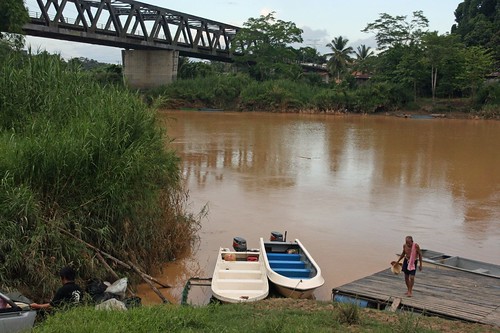
Express Boats to Uncle Tan's
I first heard about Uncle Tan’s while flipping through the pages of my Lonely Planet guidebook. “It’s not hard to spot someone who’s been to Uncle Tan’s,” says Lonely Planet, “they just can’t stop raving about the place.”
Yeah, right! Too good to be true. I made a mental note and moved on.
But when I arrive in Kota Kinabalu, I met a Frenchman at the Akinabalu hostel who had just returned from Uncle Tan’s. He had a wistful look in his eyes, a look that said you just have to experience it for yourself. So I bit.
But what did I have in store for me? What exactly is a jungle camp?
I learned a little more when I was handed a packet of information at the company’s ramshackle headquarters 16 miles outside of Sandakan.
At least they are honest. And droll.
But I’m not about to tell you a story of hardship in the jungle, of mud, tears and bitter memories. The 38 hours I spent at Uncle Tan’s were wonderful, filled with new friendships, exotic creatures and a little bit of that thing we like to call “getting back to nature.” Yes, the conditions were spartan, there was rain, mud and mosquitoes. We slept in wooden huts on foam mattresses; generators supplied electricity in the evening hours, but there were outlets recharging batteries; water was pumped from the river to the camp, for the pit toilets (surprisingly clean and not at all stinky) and any washing campers might want to do.

Sleeping Quarters
All supplies, including new mattresses, water, food and beer, were brought in daily by boat. There was a clean kitchen with a full-time cook who turned out an astonishing array of Malaysian dishes, all of them healthy and tasty. Every meal was augmented by slices of fresh fruit to cleanse the palette. The staff of young men, all of them healthy and strong from living in the jungle, was welcoming, friendly and enthusiastic. In the afternoons and evenings, they would lay in hammocks or lounge in the common area playing Malaysian rock songs on battered, out-of-tune guitars. Annoying at first; endearing in the long run.
Who needs the Hilton when you’ve got Uncle Tan’s?
You can stay at Uncle Tan’s for as long as you want, but the usual package is three days and two nights, which means you arrive in the afternoon on day one and leave in the morning on day three. Yes, you spend two nights sleeping in the jungle, but you are really only on site for about a day and a half.
My group of 11 was a mix of two Americans (both from California!) and nine Europeans. We met over lunch at Uncle Tan’s HQ and quickly bonded, sharing the information that is the stock and trade of travel: where are you from, where have you been, where are you going? From there connections are made and other subjects come up. It’s the same story whenever travelers get together, and it’s really the best way of getting information on the road. By the time we arrived at the camp, we were old friends.
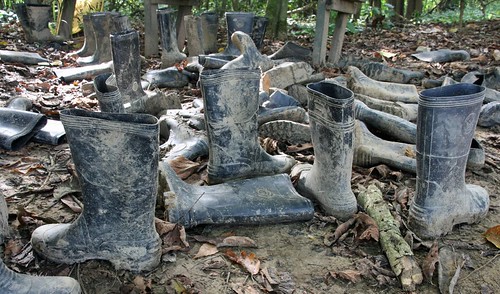
Mud Boots: A Necessity for Jungle Trekking
Over the next day and a half, we took three boat rides up and down the Kinabatangan River and through a series of ox-bow lakes, and two treks into the jungle, one during the day and one at night. The purpose of the camp is to view wildlife. Suzi, a Californian in Borneo after a stint of volunteer work in the Philippines, and Stin and Cynthia, a Belgian couple that left their kids at home, were keen on cataloging the animals, keeping a running list and hashing it out each time we returned to camp. The rest of us – a Dutch couple, Tim and Margriet, who displayed good humor and a sense of irony that I appreciated very much; professional travelers Nikki and Tom, Brits who met in India and never looked back; Angela, an ex-pat teacher living in Brunei, a land of plenty after two years in Saudi Arabia; Leah, from Ireland but living in New Zealand (she went on vacation and never went home); and Martina, a traveler from Germany – were just happy to see the creatures.
Yes, there were monkeys and apes, crocodiles, birds large and small, frogs of all colors, bugs and more bugs, scorpions venomous and harmless, monitor lizards, bearded pigs, leeches, butterflies, and a few hairy tarantulas. A mama orangutan and her baby perched in the trees above the camp, plucking fruit and dropping peels onto the huts below. Campers were atwitter over a tender moment between mother and baby, but I missed it and cannot verify this instance of animal kinship.
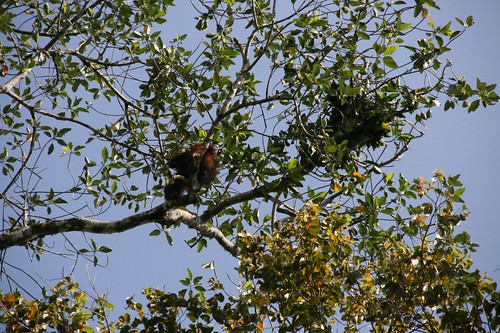
That Orange Blob? Mama Orangutan.
And we had to keep a keen eye out for the pesky macaque monkeys at mealtime – they are thieves and will take advantage of any lapse in vigilance. They had recently learned how to open the containers storing coffee, tea and sugar. It seems the macaque monkeys on the Lower Kinabatangan have a taste for Milo.
On our afternoon boat tour, our guide, Tan, who with eleven years at Uncle Tan’s has likely seen everything, stopped the boat and asked for a pair of binoculars. He scanned the trees, paused, then raised his arms and let out a whoop. “A gibbon,” he shouted. We were lucky to see this ape for a few seconds as it swung with lanky arms from one tree to another, a dark outline among the green foliage. Gibbons are rare in this part of the jungle, only appearing two or three times a year. Tan’s enthusiasm was catching and we all returned to camp full of good humor and boasting about the great gibbon in the trees.
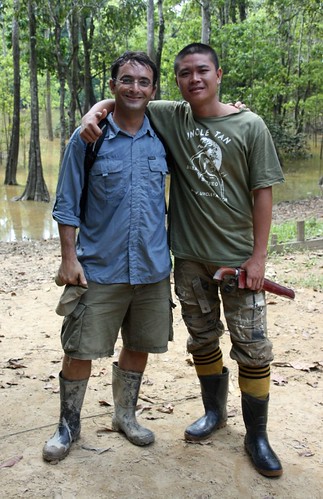
Matt and Tan
I could go on and on about all the animals, but I’d bore myself to tears. And what I'll remember about Uncle Tan’s is not really the animals. I will remember just being in the jungle, far from civilization where there are animals, yes, but also moments of utter tranquility. We woke at 6 a.m. for a boat ride to see animals, but my memories are of a rising sun obscured by heavy mist, a haze that turned an ordinary river cruise into my own (quite fictitious) journey into the heart of darkness. Imagination is a wonderful thing.
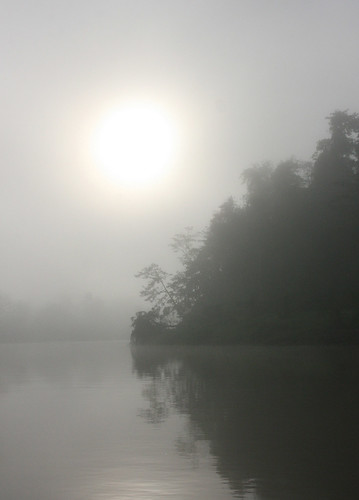
Sunrise Over Sungai Kinabatangan
A nighttime trek through swampy jungle revealed a world of nocturnal creatures – frogs and spiders mostly, but a few venomous scorpions and a hairy Blue Tarantula. At one point our guide, Loi, told us to wait as he ventured waist-deep into the swamp, the beams of his torch bouncing off the fans of the Mangrove trees. Enveloped by dark night, under a protective canopy that blocked out the light from the moon, I had a fleeting thought of nightmares, that what I was seeing is the stuff of dreams, bad dreams, and if I weren’t having such a good time I would probably cry out in terror and beg someone to take me home.
When it was time to leave Uncle Tan’s, we were given handshakes and hugs by the staff and sent on our way. We spent a minuscule amount of time in the jungle, but all of it was memorable, ranking as a highlight on this extensive tour of mine. In fact, back in Kota Kinabalu, I found myself trying to describe the place to another traveler, a wistful look in my eyes and a head full of jungle fever.
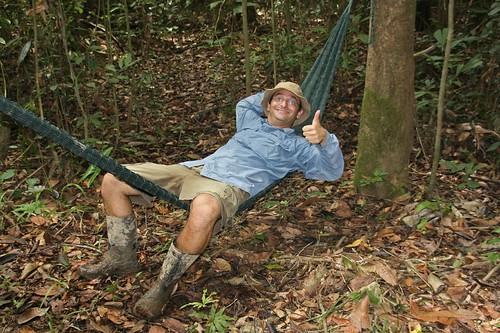
Good Times!

I first heard about Uncle Tan’s while flipping through the pages of my Lonely Planet guidebook. “It’s not hard to spot someone who’s been to Uncle Tan’s,” says Lonely Planet, “they just can’t stop raving about the place.”
Yeah, right! Too good to be true. I made a mental note and moved on.
But when I arrive in Kota Kinabalu, I met a Frenchman at the Akinabalu hostel who had just returned from Uncle Tan’s. He had a wistful look in his eyes, a look that said you just have to experience it for yourself. So I bit.
But what did I have in store for me? What exactly is a jungle camp?
I learned a little more when I was handed a packet of information at the company’s ramshackle headquarters 16 miles outside of Sandakan.
“We would like to remind visitors that the Camp is not exactly the HILTON! Facilities are Spartan in nature, but we do our best under ‘circumstances of wilderness’ to make your visit enjoyable and comfortable. The Camp is situated in a jungle environment. It is in an old riverbed by some beautiful ox-bow lakes. Insects and mosquitoes will be there… The floodwater may rise. Part of the Camp may be under water. Toilets may be under water. It can be inconvenient.”
At least they are honest. And droll.
But I’m not about to tell you a story of hardship in the jungle, of mud, tears and bitter memories. The 38 hours I spent at Uncle Tan’s were wonderful, filled with new friendships, exotic creatures and a little bit of that thing we like to call “getting back to nature.” Yes, the conditions were spartan, there was rain, mud and mosquitoes. We slept in wooden huts on foam mattresses; generators supplied electricity in the evening hours, but there were outlets recharging batteries; water was pumped from the river to the camp, for the pit toilets (surprisingly clean and not at all stinky) and any washing campers might want to do.

All supplies, including new mattresses, water, food and beer, were brought in daily by boat. There was a clean kitchen with a full-time cook who turned out an astonishing array of Malaysian dishes, all of them healthy and tasty. Every meal was augmented by slices of fresh fruit to cleanse the palette. The staff of young men, all of them healthy and strong from living in the jungle, was welcoming, friendly and enthusiastic. In the afternoons and evenings, they would lay in hammocks or lounge in the common area playing Malaysian rock songs on battered, out-of-tune guitars. Annoying at first; endearing in the long run.
Who needs the Hilton when you’ve got Uncle Tan’s?
You can stay at Uncle Tan’s for as long as you want, but the usual package is three days and two nights, which means you arrive in the afternoon on day one and leave in the morning on day three. Yes, you spend two nights sleeping in the jungle, but you are really only on site for about a day and a half.
My group of 11 was a mix of two Americans (both from California!) and nine Europeans. We met over lunch at Uncle Tan’s HQ and quickly bonded, sharing the information that is the stock and trade of travel: where are you from, where have you been, where are you going? From there connections are made and other subjects come up. It’s the same story whenever travelers get together, and it’s really the best way of getting information on the road. By the time we arrived at the camp, we were old friends.

Over the next day and a half, we took three boat rides up and down the Kinabatangan River and through a series of ox-bow lakes, and two treks into the jungle, one during the day and one at night. The purpose of the camp is to view wildlife. Suzi, a Californian in Borneo after a stint of volunteer work in the Philippines, and Stin and Cynthia, a Belgian couple that left their kids at home, were keen on cataloging the animals, keeping a running list and hashing it out each time we returned to camp. The rest of us – a Dutch couple, Tim and Margriet, who displayed good humor and a sense of irony that I appreciated very much; professional travelers Nikki and Tom, Brits who met in India and never looked back; Angela, an ex-pat teacher living in Brunei, a land of plenty after two years in Saudi Arabia; Leah, from Ireland but living in New Zealand (she went on vacation and never went home); and Martina, a traveler from Germany – were just happy to see the creatures.
Yes, there were monkeys and apes, crocodiles, birds large and small, frogs of all colors, bugs and more bugs, scorpions venomous and harmless, monitor lizards, bearded pigs, leeches, butterflies, and a few hairy tarantulas. A mama orangutan and her baby perched in the trees above the camp, plucking fruit and dropping peels onto the huts below. Campers were atwitter over a tender moment between mother and baby, but I missed it and cannot verify this instance of animal kinship.

And we had to keep a keen eye out for the pesky macaque monkeys at mealtime – they are thieves and will take advantage of any lapse in vigilance. They had recently learned how to open the containers storing coffee, tea and sugar. It seems the macaque monkeys on the Lower Kinabatangan have a taste for Milo.
On our afternoon boat tour, our guide, Tan, who with eleven years at Uncle Tan’s has likely seen everything, stopped the boat and asked for a pair of binoculars. He scanned the trees, paused, then raised his arms and let out a whoop. “A gibbon,” he shouted. We were lucky to see this ape for a few seconds as it swung with lanky arms from one tree to another, a dark outline among the green foliage. Gibbons are rare in this part of the jungle, only appearing two or three times a year. Tan’s enthusiasm was catching and we all returned to camp full of good humor and boasting about the great gibbon in the trees.

I could go on and on about all the animals, but I’d bore myself to tears. And what I'll remember about Uncle Tan’s is not really the animals. I will remember just being in the jungle, far from civilization where there are animals, yes, but also moments of utter tranquility. We woke at 6 a.m. for a boat ride to see animals, but my memories are of a rising sun obscured by heavy mist, a haze that turned an ordinary river cruise into my own (quite fictitious) journey into the heart of darkness. Imagination is a wonderful thing.

A nighttime trek through swampy jungle revealed a world of nocturnal creatures – frogs and spiders mostly, but a few venomous scorpions and a hairy Blue Tarantula. At one point our guide, Loi, told us to wait as he ventured waist-deep into the swamp, the beams of his torch bouncing off the fans of the Mangrove trees. Enveloped by dark night, under a protective canopy that blocked out the light from the moon, I had a fleeting thought of nightmares, that what I was seeing is the stuff of dreams, bad dreams, and if I weren’t having such a good time I would probably cry out in terror and beg someone to take me home.
When it was time to leave Uncle Tan’s, we were given handshakes and hugs by the staff and sent on our way. We spent a minuscule amount of time in the jungle, but all of it was memorable, ranking as a highlight on this extensive tour of mine. In fact, back in Kota Kinabalu, I found myself trying to describe the place to another traveler, a wistful look in my eyes and a head full of jungle fever.


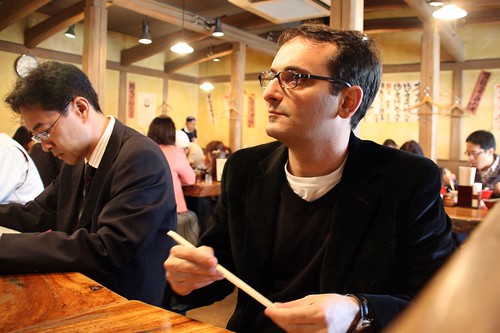

0 Comments:
Post a Comment
<< Home